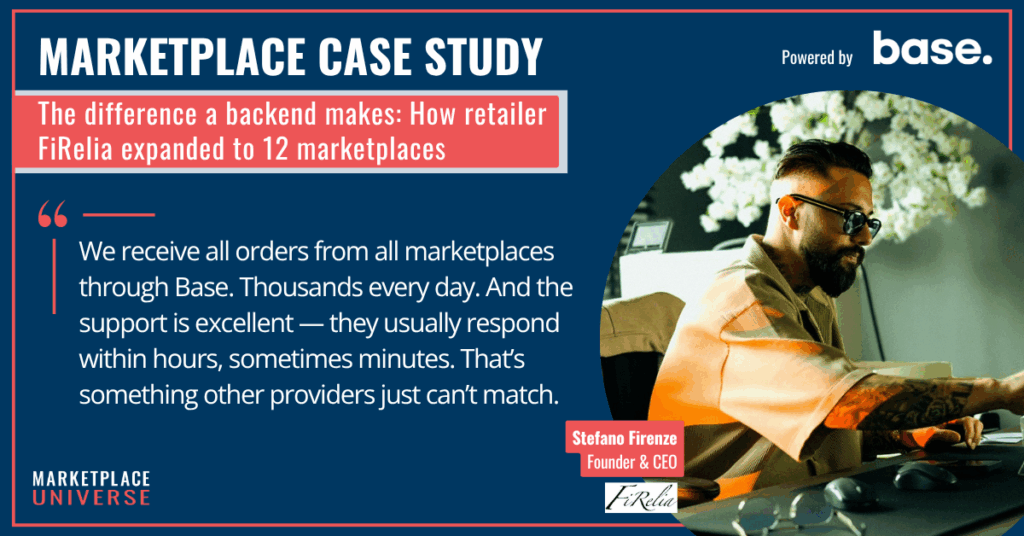
Case Study: How Retailer Firalia turned Marketplace Onboarding into a Breeze
Powered by base
When COVID-19 hit, Cologne-based online seller Stefano Firenze and his retail company FiRelia saw demand explode. Having started out in 2013 selling fashion on eBay and Amazon — first clothing, then shoes — his business took an unexpected turn when he pivoted to protective equipment during the pandemic.
“We were one of the first to sell face masks on Amazon. At the peak, we had around 20,000 orders per day.”
With only three people on his team, he had to scale quickly — ultimately growing to 20 employees. The team learned how to manage high volumes and rapid operations under pressure. But they also knew the boom wouldn’t last.
“We saw that this was a temporary phase. That’s when we pivoted to electronics — phone accessories, electric toothbrushes, that kind of thing.”
The Limits of His Old System
Until 2024, Stefano had spent ten years using the same backend provider, but the setup made it difficult to expand to new marketplaces.
“Every time we wanted to integrate a new platform, we had to build the APIs ourselves.”
That’s when his team started looking for alternatives — and decided to switch to Base. What convinced them? A large number of pre-built integrations, good value for money, and a fast onboarding process. Base is a Poland-based e-commerce operations platform that connects online sellers with hundreds of marketplaces, shop systems, shipping providers and ERPs. Headquartered in Warsaw, the company supports more than 30,000 merchants worldwide and is especially known for its broad integration landscape, fast implementation, and highly responsive support — key factors for sellers looking to scale quickly without adding complexity.
Scaling Up Without Growing the Team
The switch to Base in November 2024 ran smoothly and quickly, Stefano recounts. Since then, he has added five new marketplaces — among them Allegro, MediaMarktSaturn and others. He now sells across 12 platforms in total, including Amazon, eBay, Otto, Kaufland, and more.
“Some marketplaces approached us. Others we researched ourselves.”Despite the growth, the team remained lean: today, Stefano runs a 15-person operation, with 10 employees in the warehouse and manages an assortment of 500 to 600 SKUs, mostly fast-moving items. Product testing is ongoing: old products are phased out, new ones added. The assortment is consistent across all marketplaces.
Why Base Made the Difference
“We receive all orders from all marketplaces through Base. Thousands every day. And the support is excellent — they usually respond within hours, sometimes minutes. That’s something other providers just can’t match.”
The switch to Base has made it easier to manage complexity, test new markets, and keep operations centralized. Repricers are used on competitive platforms like Allegro, though Stefano notes the challenges:
“It’s hard to win the Buy Box — competition is tough. But that’s how it is. Sometimes you win, sometimes you don’t.”
Interestingly, Stefano rarely turns off a marketplace, even if performance is low. He prefers to keep the presence and monitor long-term. Because of his lean software setup, keeping up a channel takes little effort, after all.
For now the retailer is happy with his marketplace setup – and with the knowledge that whenever he wants to expand, he can now do so at the drop of a hat thanks to his software setup.
“We’re keeping an eye on a few platforms for Q3 and Q4, maybe one or two more launches this year.”
Key Takeaways from FiRalia’s Story
- Switching systems unlocked fast marketplace expansion
- Five new marketplaces launched within six months
- Centralized operations handle thousands of daily orders
- Lean team, direct imports, and UPS setup power a fast fulfillment model
- Support quality made a clear difference